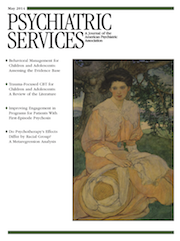Treatment of Obsessive-Compulsive Disorder in a Nationwide Survey of Office-Based Physician Practice
Abstract
Objective
This study examined treatment of obsessive-compulsive disorder (OCD) in office-based practice.
Methods
Data from the 2003–2010 National Ambulatory Medical Care Survey, a nationally representative survey of visits to U.S. office-based physicians, were used to examine outpatient visits involving treatment of adults with OCD.
Results
Among the 316 visits with a diagnosis of OCD, most were to a physician seen previously by the patient (96%), usually a psychiatrist (86%), and most patients (56%) had seen the physician at least six times in the previous year. Most visits included psychotropic medications (84%), most commonly a serotonin reuptake inhibitor (SRI) (69%). Visits less commonly included psychotherapy (39%).
Conclusions
OCD was predominantly treated by psychiatrists using SRIs, despite the prevalence of OCD in primary care and SRI prescribing practices in that setting. Given the potential shift in OCD treatment patterns after health care reform, research on OCD treatment in primary care is warranted.



